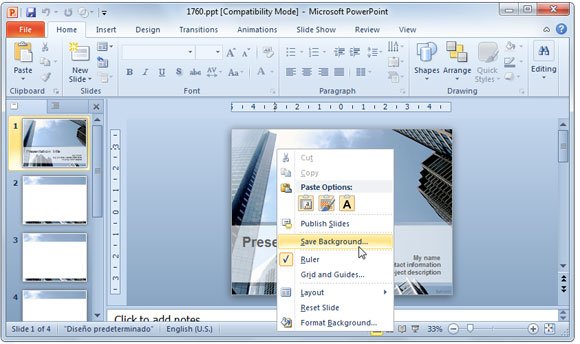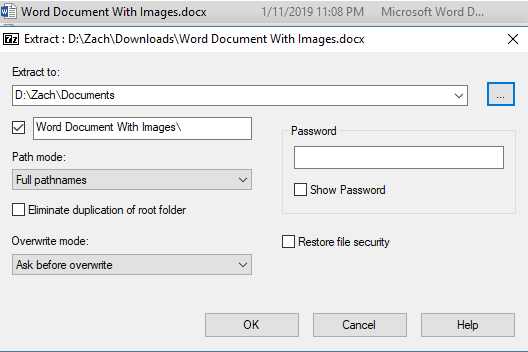Step 6: Now, open the Apple Pages app and go to File Open. Alternatively, you can use the keyboard shortcut Command + O to open the file from the Mac. Step 7: Locate to the Word file and open it on Pages. Step 8: The software will automatically convert the file type from Word to Pages during the opening process. Well just open the document in Word and save it as.docx file, Word will convert it to a zip/docx file for you. So here is my file: Note: if you do not see the.docx at the end of the file name, you.MUST. follow this tutorial for this to work (this will help you show file extensions in Windows Explorer). My project is about to extract files from Microsoft Word Documents. For instance, I have a word document. In the document, there are several embedded files such as pdf, gif, or jpg. I want to separate the embedded files from the word document without opening it and resave the sepeated files into a directory. Open any Office app. You can activate Office from any of the included Office apps, such as Microsoft Word. To open Word, open Finder, select the Applications folder, and then double-click Microsoft Word in the 'Microsoft Office' section. In today’s article, we will provide you with 2 quick ways to extract all the MS office files embedded in your Word document. Every so often, we could inherit a Word document containing multiple embedded files, such as below: Normally, to export them, we will have to open the file and then save it.

 OK, the problem is not the size of the file: 4MB is 'tiny' in the grand
OK, the problem is not the size of the file: 4MB is 'tiny' in the grandscheme of things. A Word file can up to about 2 GB before it fails, if you
can stand the slowness.
The issue is likely to be the complexity of the code within the file: you
have documents within documents...
Things that will make this issue worse: 1) Tracking changes, 2) Automatic
Numbering, 3) Tables, 4) Different versions of Word, 5) Different file
formats.
If you were to upgrade each of the embedded documents into the latest .docx
format, then save the main file as .docx format, then re-embed the pictures
as .docx, you would produce a more reliable document. It would certainly be
a lot smaller (because .docx is tightly compressed). And it would give less
trouble opening the embedded files because everything would be the same
version.
And keep those backups :-) The problem won't sort itself out, it will
simply continue to get worse with each update to the document until you
can't open the file.
Hope this helps
On 28/02/10 1:11 PM, in article 59bb302d.3@webcrossing.JaKIaxP2ac0,
'mgoe...@officeformac.com' <mgoe...@officeformac.com> wrote:
This email is my business email -- Please do not email me about forum
matters unless you intend to pay!
--
John McGhie, Microsoft MVP (Word, Mac Word); Consultant Technical Writer,
McGhie Information Engineering Pty Ltd, Sydney, Australia.
Ph: +61 (0)4 1209 1410; mailto:jo...@mcghie.name
TechNote 73
Applicability
| The information on this page applies to: | |
|---|---|
| All supported versions of Word for Windows and Mac |
Issue
Many users become alarmed when the equations in their Microsoft Word document is displayed in the cryptic form of { EMBED Equation.DSMT4 } or { EMBED Equation } instead of the actual MathType or Microsoft Equation equations.
Reason
Extract Embedded File Word Office For Mac Download
These representations are a feature in Microsoft Word called Field Codes. They are used to help Word identify objects, such as equations, in your document. You only see them when the option is turned on, in which case they appear on-screen, in print, or both on the screen and in print.
Solution
{ EMBED Equation } or { EMBED Equation.DSMT4 } on screen
If you find that your equations are not displaying on-screen but instead are displaying something like { EMBED Equation } or { EMBED Equation.DSMT4 }, you can change your view settings in Word to correct this. To do so,
- Select
- Office Button > Word Options > Advanced (Word 2007)
- File tab > Options > Advanced (Word 2010 and later)
- Uncheck the box for 'Field Codes' or 'Field codes instead of values'.
At this point, the equations contained within the Word document should display correctly. Other ways you can toggle this property are:
- Via keystroke; the Word keyboard shortcut is Alt+F9 (Win) or ⌥+F9 (Mac).
- Via the Word toolbar; the toolbar button in Word looks like '{a}'. This is not one of the default buttons but can be added to the Word toolbars by using Word's Customize command. For more information about customizing your Word toolbars, please consult your Microsoft Word online help.

Any of the above methods will allow you to toggle the field codes off and on that will allow you to see the equations.
{ EMBED Equation } or { EMBED Equation.DSMT4 } in print
If you find your equations are not printing but instead are displaying something like { EMBED Equation } or { EMBED Equation.DSMT4 }, you can change your print settings in Word to correct this. To do this:

- Select Word > Preferences (Word for Mac), or Office button (or File tab) Options (Windows).
- Select the Print button (Mac) or Advanced/Print (Windows).
- Uncheck the box for 'Field Codes' or 'Print field codes instead of their values'.
At this point, if you print your document, the objects contained within the Word document should print out correctly.

Extract Embedded File Word Office For Mac Os
We hope this has been helpful. As always, please let us know if you have questions about this, or if you have additional techniques that work. We'd love to hear from you.
